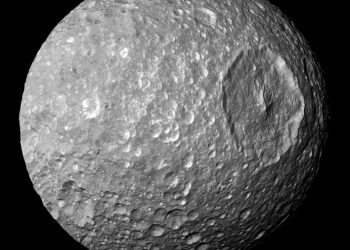
Titan, Saturn’s largest moon, is the only body in our solar system aside from Earth known to harbor stable liquids on its surface. These vast expanses of liquid, however, are not water but hydrocarbons such as methane and ethane, forming seas, lakes, and rivers that dot Titan’s polar regions. New research now shows that these seas also have active tidal currents, small-scale waves, and increased roughness near estuaries and straits.
A different type of seas
When you think about planets and moons that resemble Earth, you’d probably think of Venus, Mars, or the Moon. But if you’re looking for surface liquids, those pale in comparison to Titan.
Titan is the largest moon of Saturn and the second-largest natural satellite in the solar system. Its diameter is larger than the planet Mercury and around 2.5 times smaller than Earth. Titan is unique as it has an atmosphere — but it’s not an atmosphere made of oxygen and nitrogen, like Earth’s. Titan’s atmosphere is composed of approximately 95% nitrogen and small amounts of methane and other hydrocarbons.
If you look at Titan’s surface, you’d probably be surprised by the large diversity of geological features. The moon has vast dunes, icy plains, rivers, estuaries, and even seas. It even has a liquid cycle, with clouds and rain that mirror Earth’s water cycle. But Titan’s surface is extremely cold, with temperatures of around -179 degrees Celsius (-290 degrees Fahrenheit) — so this isn’t liquid water.
Researchers are now confident that these are hydrocarbon seas, mostly methane. This alien mix of familiar geology and completely different chemistry makes Titan so bizarre and so fascinating.
In the new study, scientists led by Valerio Poggiali from Cornell University used radar data to show just how much these seas resemble Earth’s.
Cassini — the gift that keeps on giving
The Cassini mission, which orbited Saturn from 2004 to 2017, provided unprecedented details about Titan’s surface, particularly its seas. A recent analysis of data from Cassini’s bistatic radar experiments has unveiled significant details about the surface properties and composition of these mysterious seas.
Bistatic surveys differ from traditional monostatic radar by using separate locations for the transmitter and receiver. Cassini’s bistatic radar observations involved transmitting signals from the spacecraft and receiving the echoes on Earth. This method allows for more detailed analysis of surface properties.
These experiments measured the reflected signals’ power and polarization, providing valuable data on the surface’s dielectric constant and roughness.

The bistatic radar data revealed significant variations in the dielectric constant across different regions of Titan’s seas, suggesting that there are compositional differences between different seas on Titan. For instance, Kraken Mare, Titan’s largest sea, showed higher dielectric constants compared to Ligeia Mare, indicating a greater ethane content in Kraken Mare. This compositional gradient aligns with the expected latitudinal variation in precipitation and evaporation rates on Titan.
The radar data also indicated variations in surface roughness, with smoother surfaces in the open seas and rougher textures near estuaries and inter-basin straits. This hints at the existence of small surface waves of a few millimeters that are causing the roughness. In turn, these differences suggest active tidal currents in certain regions, similar to the tidal effects observed on Earth’s coastal areas.
So once more, pretty similar to Earth
The dynamics of these liquids on Titan are all very similar to the seas we have on Earth.
Like Earth’s seas, Titan’s seas have varying compositions, with regions showing differences in methane and ethane concentrations, similar to how some seas and oceans on Earth have more or less salinity.
Estuaries on Titan show distinct compositions where methane-rich rivers mix with ethane-rich seas, paralleling Earth’s river-ocean interactions. Additionally, the presence of tidal currents in Titan’s seas suggests active, Earth-like processes that shape its coastal landscapes. This also fits with findings from previous studies that studied the waves and islands on Titan.
These findings enhance our understanding of Titan’s complex hydrocarbon cycle and set the stage for future exploration of this intriguing moon.
Journal Reference: Poggiali, V., et al. “Surface properties of the seas of Titan as revealed by Cassini mission bistatic radar experiments.” Nature Communications, 2024.






